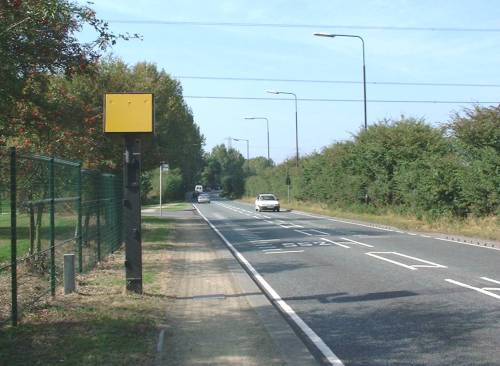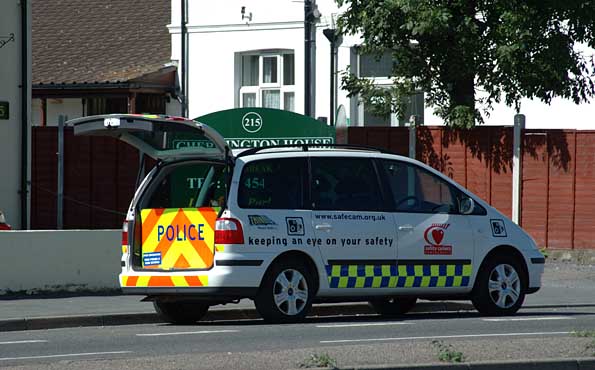Speed Cameras Revisited
An update of recent trends in speed enforcement

|
Speed cameras are now painted in high-visibility colours, but there are far more of them. |
In 2000 I wrote a piece about speed camera policy entitled A Nice Little Earner? One the main points was to question the widely-held view that speed cameras raised large sums of money for the authorities, although it also addressed other issues of siting and visibility. Since then, a large number of changes have happened to speed camera policy. Rather than attempt to rewrite the page I felt it better to leave it as it was, and produce a separate update here.
Conspicuity
The most obvious change that has occurred is that virtually all speed cameras are now painted in high-visibility colours. As I said before, when cameras were painted grey, they were inconspicuous rather than hidden, and even the ones concealed behind signs and bushes could be spotted from the other direction. This meant that locals tended to know exactly where they were and they only posed a risk to outsiders using the road. However, the fact that many speed cameras were hard to spot was hugely destructive of public trust in the system, as when a camera is placed behind a sign it sends out a clear message that the objective is entrapment rather than deterrence. Therefore the decision was taken to bring the cameras out into the open and paint them in bright colours. This, I feel sure, was done somewhat reluctantly by government, and was primarily seen as a confidence-building measure rather than something that in itself would enhance safety.
The result is that fixed cameras now pose much less of a risk to the licence of the observant driver. Combined with the widespread availability of GPS-based speed camera location systems (which were only just being introduced in 2000) the threat from fixed cameras has largely been defused. This is not to say that watching out for cameras rather than genuine hazards makes the roads safer – of course it doesn’t – but someone would have to be exceptionally unlucky or unobservant to end up with a totting-up ban purely from fixed cameras.
Camera Numbers
The cameras may have been made more visible, but there are far more of them than there were in 2000, and they are enforcing ever more inappropriate speed limits. It is very difficult to obtain accurate figures for the total number of cameras, but as a rough estimate their numbers have more than doubled from less than 2000, to nearly 5000 now. In 2002, my local area of Stockport installed about 15 new cameras, where previously there were only three. Their numbers have greatly increased in Cheshire, where they were very sparse, and they have appeared for the first time in the High Peak district of Derbyshire. The story is much the same all over the country – a look at the maps of the Midlands on www.speedcam.co.uk shows them thickly covered with black dots representing Gatsos, many of which have appeared in the past four or five years.
At the same time, there has been an epidemic of reduced speed limits, many of which in my local area are listed on my Speed Limit Reductions page. All too often, cameras are introduced at the same time, or shortly after the limit being slashed – prime examples being the A666 St Peter’s Way in Bolton and the A34 Handforth bypass in Stockport, both of which are high-quality, pedestrian-free dual carriageways where the limit was cut from the National Speed Limit (70 mph) to a mere 50 mph.
Revenue
Back in 2000, when speed cameras were controlled by the police, it was fair to say that they were not a significant source of revenue for the authorities, and they couldn’t really be branded as “revenue-earners”. However, all this has changed with the roll-out of the “Safety Camera Partnerships”, which back then were only at the trial stage. Now there are only a small handful of police force areas that have not created their own partnership. The key point about these bodies is that the operation of the cameras, and all their overhead expenditure, is funded from the fine revenue from camera prosecutions, not from general taxation.
In terms of the totality of tax revenue this income is still only a relatively small figure, but, even so, 3 million convictions at £60 each produces a sum not to be sneezed at. And the key feature of this system is that it effectively provides an incentive to the partnerships to maximise their revenue, so it will pay for expanded payroll and comfortable new offices. The result is that their objective becomes to increase the number of prosecutions rather than overall improving safety. This is an absolutely invidious system that is the single biggest aspect of speed camera policy that is in need of reform. It is quite unacceptable that those enforcing the law may profit from the way they carry out that enforcement.
Talivans

|
The Talivan has replaced the Gatso as the bane of the motorist's life. This one is highly visible - but many are well concealed (courtesy of www.speedcam.co.uk ) |
Making fixed cameras highly visible greatly reduced their revenue-raising potential, even if there were many more of them. So how were the newly-created Safety Camera Partnerships to fund their activities?
The answer was a greatly increased use of mobile enforcement using camera vans, which were rapidly dubbed “Talivans”. These must now provide the major share of partnership revenue. They are supposed to be painted in distinctive colours and parked in prominent locations, but in practice until you’re close up one white van looks much like another, and examples of them being placed as inconspicuously as possible are numerous, as extensively documented on the www.speedcam.co.uk site. This even records an example of a Talivan operator in North Wales parking his van on the far side of a NSL sign to catch drivers speeding up within a 30 limit just before they reach the sign.
As they are deployed in a variety of locations, the level of observation needed to identify Talivans is much greater than that needed to spot fixed cameras, and the result is often than drivers simply slam the brakes on every time they spot a white van parked by the roadside.
This is the other aspect of speed enforcement policy that really needs to be scrapped. I accept that a limited use of fixed cameras may be appropriate in some circumstances, but mobile camera vans are wholly unacceptable. The point of a fixed camera is that in provides a permanent deterrent at a specific location, which a mobile van simply cannot do. The sole point of talivans is to catch out the unwary. Mobile enforcement does have a place, but it needs to be done using live police officers who can actually apprehend and speak to offenders at the time of the offence. See After the Cameras for a more detailed exposition of my views on speed enforcement in the post-camera era.
Safety
The purpose of speed cameras, both fixed and mobile, is of course in theory improving safety, not raising revenue. Yet on this point their record does not appear to be an impressive one.
The road fatality figures for the most recent 10 year period for which figures are available – which broadly covers the “speed camera era” are:
|
GB Road Fatalities
1993-2003 |
|
| Year | Fatalities |
| 1993 | 3814 |
| 1994 | 3650 |
| 1995 | 3621 |
| 1996 | 3598 |
| 1997 | 3599 |
| 1998 | 3421 |
| 1999 | 3423 |
| 2000 | 3409 |
| 2001 | 3450 |
| 2002 | 3431 |
| 2003 | 3508 |
For the period since 2000, which is when the number of cameras has really mushroomed on the roads, the annual fatality figures actually show an increase.
In contrast, between 1973 and 1983, fatalities fell from 7406 to 5445, a drop of 26%, and from 1983 to 1993 they fell from 5445 to 3814, a drop of 30%. The next ten years saw a fall of only 8%, all of which was in the first half of the period. Given continued improvements in medical care for accident victims, and in the crashworthiness and pedestrian protection of vehicles, you might have expected the figures to continue to fall at a similar rate, but this clearly hasn’t happened. This suggests that something has gone seriously wrong with road safety policy.
The Safety Camera Partnerships often claim impressive figures for casualty reductions “at camera sites”. However, if the overall casualty figures in their area show no reduction, all the cameras are doing is moving the accidents around. There is also the factor of “regression to the mean” – inevitably there is a random element to the distribution of accidents, so if a speed camera is installed at a location where there has been a high number of accidents in recent years, it is very likely the number will reduce after the camera is put there. There is also no noticeable advantage in casualty trends for police force areas with numerous cameras such as Staffordshire, over those with few or none such as Durham.
Indeed, it can be argued that the proliferation of speed cameras actually tends to make safety worse, for the following reasons:
- They encourage the view that sticking to the speed limit is an important factor in driving safely
- They tend to lead drivers to pay more attention to watching out for cameras than to looking for genuine hazards
- The rise of cameras has been accompanied by cuts in traffic police numbers. A camera can only detect speeding, and can do nothing about drunken, drugged or unlicensed driving
- They encourage people to drive unlicensed or cloned vehicles to evade detection
What is certain is that cameras are not the safety panacea that was claimed when they were first introduced. Taking the most charitable view, their contribution to improving safety is very small, but it is much more likely that their overall impact is actually a negative one. As camera numbers mount, and fatality figures refuse to fall, the claim that speed cameras provide a safety benefit becomes less and less convincing.
(March 2005)
Speed Camera Locations in and around Greater Manchester